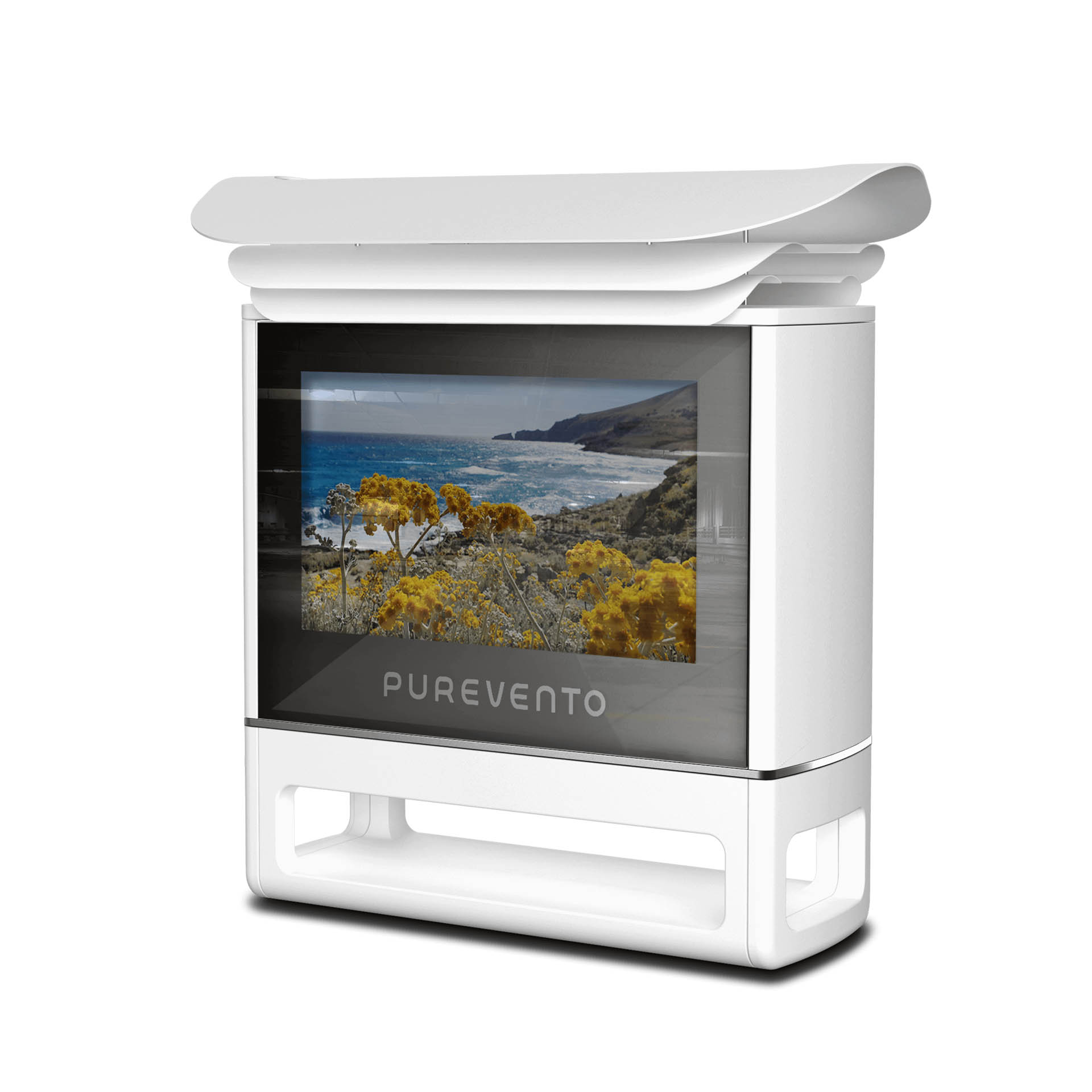Discover new things
in fresh air
Relaxed stay in public indoor spaces
The invisible threat of airborne viruses is far from over. People want to feel safe when they stroll through shopping centres, attend concerts and exhibitions, go about their work or use leisure and sports centres. Even when travelling or on public transport, where contact with many people is unavoidable - it must be possible to breathe deeply without worrying about the risk of infection.
Effective air purification is the key to minimising the risk of infection with virus-containing aerosols indoors, as has been demonstrated in numerous studies. In premises where permanently installed ventilation and air-conditioning systems are lacking or provide only insufficient air quality, professional mobile air purifiers are a good solution.
Product
Room solution
M-8 Effective ventilation for highly frequented indoor zones
With a volume flow of up to 8,000 cubic metres per hour, the M-8 air filter ensures a continuous supply of freshly cleaned air. The unit can clean an area of more than 500 square metres virus-free at an air exchange rate of six and a room height of 2.50 metres.
The removal of virus-containing aerosols is done with HEPA filters, which are mainly used in the medical sector. They guarantee a filtering performance of viruses and bacteria of at least 99.95 percent.
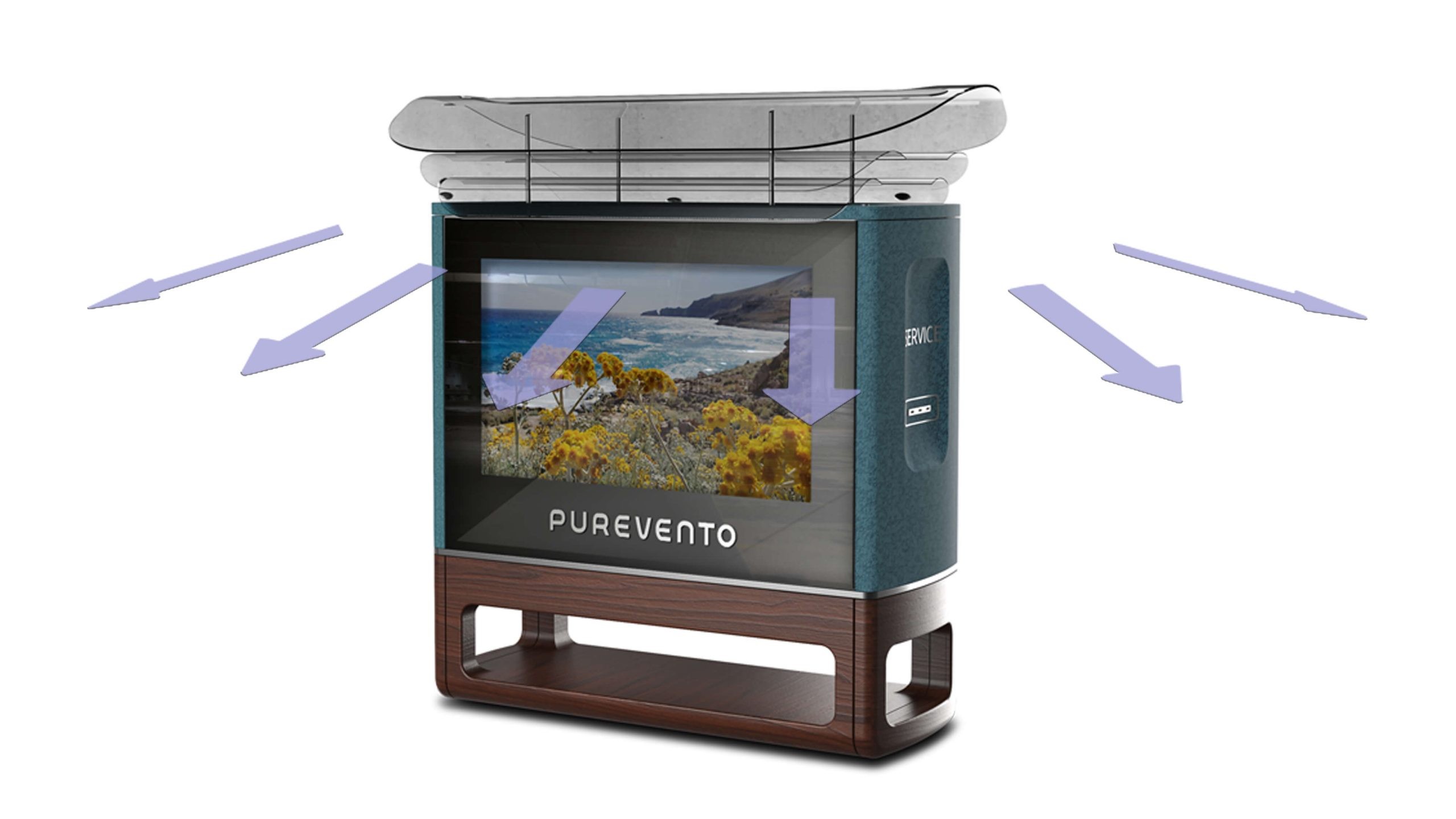
Additionally to a continuous setting the device has two power levels with reduced noise development for effective air filtration during opening hours with public traffic and meetings. The air purifier is mobile, easy to maintain and remote-control. With several air filters and a matching roof attachment to guide the air flow, even larger areas can be cleaned.
Optional Features
- Large displays for infotainment and advertising
- Customer services such as charging station for mobile devices and WLAN access
- Design to match the ambience
- Colour scheme in corporate design with company logo
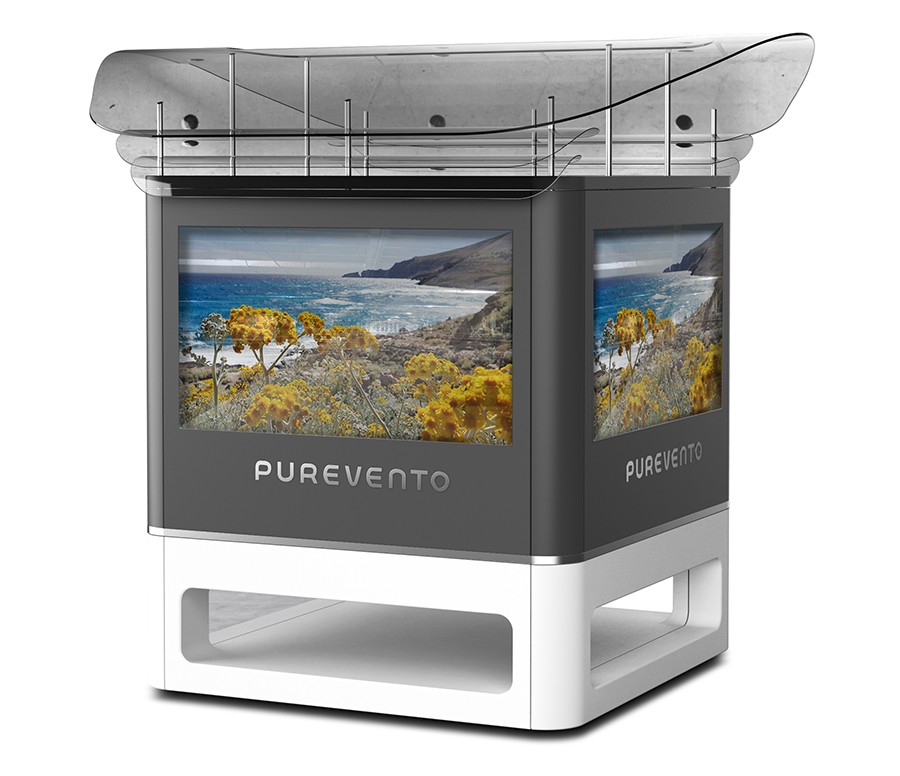
M-16 Effective ventilation for large spaces
The indoor air cleaner M-16 has a cleaning capacity of 16,000 cubic metres per hour. This makes it ideally suited as a supplement for permanently installed ventilation systems (HVAC) on large areas in high buildings with changing use, such as trade fairs, congresses and exhibitions.
This variable use of space has the disadvantage that the HVAC system cannot provide effective ventilation of homogeneous quality due to air turbulence caused by obstacles in the room. This deficiency can be remedied by additional mobile room air filters such as the M-16.
It is optionally available with four large-area displays for infotainment or advertising.
Applications
Gatherings and Events
If ventilation is inadequate, even a single infectious person can trigger an infection cluster. Wherever there is no permanently installed air-conditioning and ventilation system or it is not designed to meet pandemic requirements, there is an increased risk of infection. This is because the smallest particles such as viruses and bacteria remain in the air for hours after exhalation and can be contagious. This is especially true for assembly halls with as concerts, events, trade fairs, congresses and mobility hubs, where many people are present at the same time.
The M-8 air filter can be used as a stand-alone unit. A demand-oriented installation of several units in a system network allows for scalable, large-scale protection zones with purified breathing air. With the help of our airflow simulations, we determine a custom-fit solution for every space.
M-8 Filter solution for large rooms

The M-8 air filter is ideal for waiting areas at control points, checkouts, washrooms or in narrow passages. Multiple units in a system network scale to large protection zones in which the local breathing air is significantly improved by targeted air routing and filtration in HEPA quality.
Typical areas of application are shopping centres, railway stations and airports, hotel lobbies, reception halls and business lounges, canteens and lounges as well as public buildings.
M-16 Power solution for big halls

The M-16 air purifier reliably cleans the ambient air of virus-containing aerosols and other suspended matter in all places with high public traffic. There, a high air flow rate is required everywhere to minimise the risk of infection.
The power solution is particularly suitable for use in event locations, congress and exhibition halls as well as theatres, music halls, museums and public buildings.
Working principle
Effective ventilation
The M-8 air filter creates local breathing protection zones with high air quality through the use of HEPA filters and active guidance of the air flows through the roof construction. The special feature of our air filters is the supply of purified air from above, analogous to the airflow in an aircraft.
- Purified air is discharged directly into the breathing zone
and thus has no opportunity to mix with contaminated ambient air - Exhaled air is continuously exhausted downwards
and directly drawn in by the unit to remove virus-containing aerosols - Aerosols that are harmful to health do not spread further
due to the vertical air conduction

Part of the purified airflow is discharged upwards into the room and helps to reduce the concentration of virus-containing aerosols in the room. The M-8 air purifier cannot replace a room air conditioning system. It is an effective supplement for all areas with special room geometry or zonal structures that cannot be cleaned to the required extent by permanently installed stationary ventilation systems.
The volume flow of the M-8 air purifier is infinitely variable. In addition, three performance levels are preset, which have been optimised with regard to noise levels for meetings and public spaces:
- Effective cleaning with minimal noise (Silence mode)
during meetings, lectures or conferences - Effective cleaning with a latent, natural noise level (Public mode)
in shopping centres, public buildings or mobility terminals - Highly effective, fast cleaning before active usage phases and during breaks (Power mode)
in all rooms with high public traffic and longer periods of use and dwell time
Benefits
Affordable health protection
Relaxed attendance at events and gatherings
In times of pandemics, it sometimes looks as if good health care and a functioning economy are irreconcilable opposites. The professional indoor air filter M-8 combines both elements:
Health aspects
- Building trust through a visible investment in health protection and well-being of customers
- Proof of effective ventilation as a central component of every hygiene concept for obtaining the operating licence
- Sensible supplement to permanently installed air-conditioning and ventilation systems for increased protection against infection in all areas with longer periods of occupancy.
Commercial aspects
- Demand-oriented local impact supplement to an existing HVAC system for variable room designs and usages
- Flexible professional solution with universal application possibilities for all room sizes and geometries
- Financing through own or third-party advertising via integrated info screens
Technology
Innovative solution with proven technology
Effective airflow with innovative roof design
When procuring air purifiers, care must be taken to ensure that they are sufficiently dimensioned for the room and application under consideration to significantly reduce the particle and virus load. The air flow rate of the device is of greater importance than the pure efficiency of the filter, says the Society for Aerosol Research in its "Position Paper on Understanding the Role of Aerosol Particles in the SARS Cov-2 Infection Event" of December 2020.

With its volume flow of 8,000 cubic metres per hour, the M-8 air purifier can reduce the virus load by 95 percent within a radius of 10 metres.
For larger areas, we will be happy to prepare a ventilation concept to determine the optimal amount and distribution of purified air flows for minimum virus concentration.
Effective filtration with optimised filter system
The purification of the sucked-in air from viruses and bacteria takes place in a two-stage filter system:
- Filtering infectious aerosols with HEPA filters
HEPA filters have the advantage that, in addition to aerosols containing viruses and bacteria, they also filter ultra-fine dusts from the ambient air, which can penetrate deep into the lungs and increase susceptibility to respiratory diseases. The filter efficiency is at least 99.95 percent according to EN 1822 and ISO 29463. - Increasing filter efficiency with fine dust pre-filters
Upstream fine dust filters ensure that the service life of the high-quality HEPA filters is increased. - Optional disinfection of viruses within the unit
If desired, the viruses in the unit can be deactivated by means of UVC light.
Test model M-8 Corporate Line
The fully functional prototype serves as the basis for the new indoor air purifier.

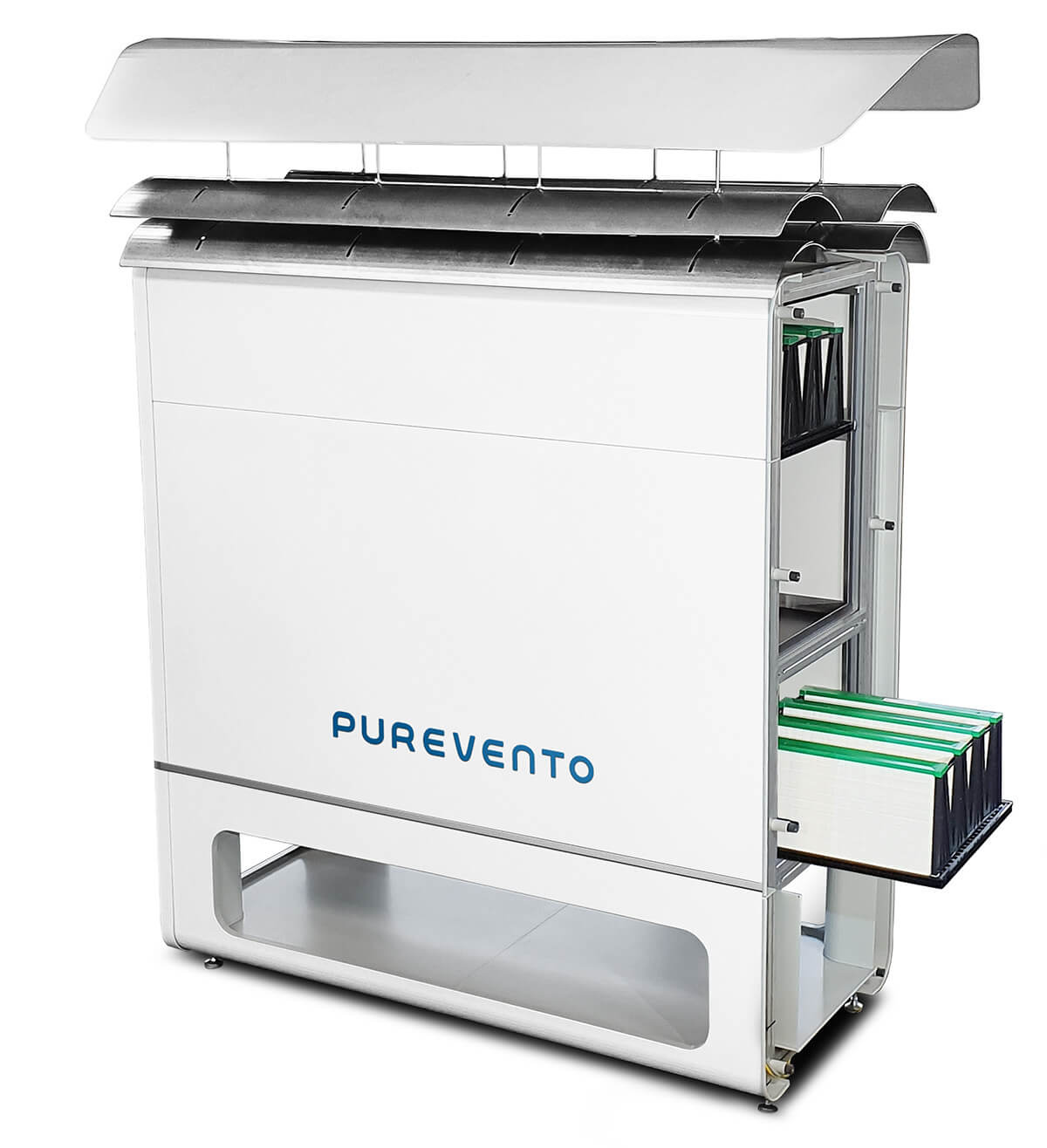
Advantages
Overview
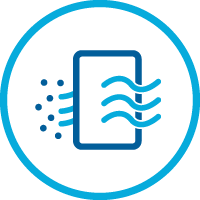
Effective
Effective prevention of the spread of virus-containing aerosols with HEPA filters


Modular
Effective stand-alone solution
with scaling option for large areas
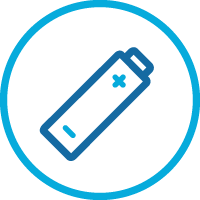
Efficient
Minimised operating and maintenance costs through needs-based design of the system solution

Mobile
Plug & Play with connection to the standard power supply

Intelligent
Sophisticated combination of patent-pending innovations and proven technologies

Low noise
Demand-led cleaning of the air with optimised performance and noise levels


Effective
Effective prevention of the spread of virus-containing aerosols with HEPA filters

Modular
Effective stand-alone solution
with scaling option for large areas

Efficient
Minimised operating and maintenance costs through needs-based design of the system solution

Mobile
Plug & Play with connection to the standard power supply

Intelligent
Sophisticated combination of patent-pending innovations and proven technologies

Low noise
Demand-led cleaning of the air with optimised performance and noise levels
Customized solution
Modular and scalable
We offer you a modular, scalable air purification solution for your indoor health management. For this, we create an air quality concept tailored to the respective area of application for local protection zones in accordance with the statement of the Commission on Indoor Air Hygiene (IRK) at the Federal Environment Agency of 12.8.2020 for effective indoor air purification:
- Adjustment of the air flow rate to local conditions and room occupancy
- Detection of airflow and air conduction in the room
Based on this, we determine the optimal number and placement of air purifiers for your facilities.
We are happy to advise you: sales@purevento.com
FAQs
Frequently asked questions
How do viruses (e.g. SARS-CoV-2) and bacteria spread?
Leading virologists have discovered that almost half of the risk of infection is due to droplets that are emitted when breathing and speaking, and to a greater extent when sneezing or coughing. They fall to the ground in a radius of about 1.50 metres.
Aerosols play a major role in the spread of COVID-19. They consist of tiny virus-containing particles that remain in the air like fine dust, swirl and are transported over long distances. They are contagious for several hours. To become infected, it is sufficient to breathe in the virus-contaminated air after the infected person has been in the room. Transmission through aerosols has also been proven for measles, tuberculosis, influenza and Sars-CoV-1.
How can the risk of infection via aerosols in the air be effectively reduced?
According to recommendations of the WHO and the German Robert Koch Institute, personal distancing and face masks help to prevent the risk of infection through droplets and aerosols. However, only FFP2/3 masks, which are mainly used in the medical sector, offer effective protection.
In closed indoor rooms, effective ventilation is therefore crucial to minimise the risk of infection from aerosols containing viruses in the air.
There is a ventilation system. How well can it reduce the risk of infection?
Permanently installed ventilation and air-conditioning systems (HVAC) can contribute to reducing the risk of infection. This is all the greater the more fresh air is supplied - ideally 100 per cent outside air. This dilutes the existing room air and thus reduces the concentration of virus-containing aerosols in the breathing air. So far, it is not certain what concentration of viruses triggers an infection.
Room air conditioning systems are designed specifically for the respective rooms and must take superstructures and flow obstacles into account as much as possible. Especially in the case of variable room use, such as function rooms and event halls, these can prevent the optimum air quality from prevailing in all usable areas. In this case, professional mobile air purifiers are a good supplement for zonal air quality management.
Can the risk of infection be eliminated with a high air exchange rate?
So far, it is not certain what concentration of viruses triggers an infection. The air exchange rate describes how often the total air volume in a room should be mathematically exchanged with fresh air in one hour. The prescribed air exchange rates for public rooms of 4 - 8 times per hour are based on general pollutants in the air such as the CO2 concentration. In the medical sector, where viruses have had to be taken into account exclusively up to now, significantly higher air exchange rates of 12 - 15 times per hour apply. According to Lufthansa, this increased air exchange rate is also used in aircraft.
The air flow rate of the device is of greater importance than the pure efficiency of the filter, according to the Society for Aerosol Research in its "Position Paper on Understanding the Role of Aerosol Particles in the SARS Cov-2 Infection Event" of December 2020.
The air exchange rate also says nothing about how the air flows of supply and exhaust air from the occupied and breathing zones are distributed in the room, i.e. about the ventilation-induced dispersion behaviour of virus-containing aerosols in the room air: the further infected aerosols spread in the room, the higher the risk that the concentration of dangerous aerosols in the room will increase overall and thus also the risk of infection.
Even a single infectious person can possibly spread enough virus-containing aerosols to infect the people in their immediate vicinity or even via the room air. The longer the time spent next to a person infected with COVID-19, the higher the risk of infection. This makes effective, professional air purification in all indoor areas with public traffic all the more important.
How are viruses filtered out of the air?
Viruses and bacteria are emitted together with aerosols, i.e. small particles that can float and swirl in the air. These aerosols are usually larger than 1 micron.
Aerosols containing viruses can be removed from the air stream with a HEPA filter. This filter technology is proven in medical areas and reduce aerosols containing viruses and bacteria to > 99,95 percent.
An upstream fine dust filter ensures a longer service life of the finer-pored and more expensive HEPA filter. We use certified high-performance filters from renowned manufacturers with international availability.
Are the viruses inactivated in the filter?
Optionally, UVC lamps can be used for disinfection in the unit.
What size of room can be cleaned to suit infection?
The indoor air purifier M-8 for professional use can purify a maximum of 8,000 cubic metres of air per hour from viruses, bacteria and microbes. It can effectively clean a room with an area of over 500 square metres or up to 1,300 cubic metres of aerosols containing viruses. This applies to an air exchange rate of six and a room height of 2.50 metres .
How loud is the air purifier?
As the room size increases, higher volume flows are required to remove airborne viruses and bacteria from the existing room air by means of HEPA filters. This is accompanied by an increase in fan noise.
The air filter is designed in such a way that the optimum cleaning performance for two typical areas of use - conversations and public traffic in public spaces - simultaneously meet the requirements for noise emissions and enable efficient operation
What kind of connection does the unit need?
The anti-virus filter requires a 230 volt power connection and can be put into operation immediately.
What are the running costs?
The running costs consist of the electricity costs depending on the duration and intensity of use. In addition, there are the filter changes according to the recommendations of the filter manufacturers. The proper functioning of the filter system is continuously monitored telemetrically. The filters have to be changed approximately every six months.
How are the air filters controlled?
The air filters can be controlled manually or by remote control. Usually, an operating mode is defined for different time periods i.e. opening ours and controlled automatically. Sensor-driven control, e.g. via CO2 sensors or people counting, is also possible.
The technical key figures are recorded telemetrically and monitored automatically. An alarm function ensures that any malfunctions become known immediately and can be remedied.


